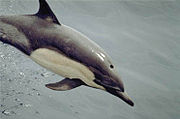Common Name: Common Dolphin
General Description: The Common Dolphin has a slender body, and a long beak separated by a crease from the melon. The prominent dorsal fin may be triangular or falcate, and the flippers taper to a pointed tip.
The colour pattern of common dolphins is striking. It is dark brown above, including the dorsal fin, tail flukes, beak and flippers. There is a light cream-yellow hourglass pattern on the sides. The tail stock and rear flanks are grey. There is a black stripe from the black eye-patch to the front of the melon and another from the chin to the flippers.
Common dolphins often have squid sucker marks on the chin and lower jaw.

Size: Adults, male common dolphins grow to 2.6m in length, and females to 2.3m. The weight is usually not more than 75kg. Calves at birth, 90cm long.
Appearance At Sea: Common dolphins are playful animals, rolling and leaping in the water. They are found in groups sizes ranging from three to 200, or in herds of many hundreds.
Common dolphins’ speeds may exceed 40 kilometres per hour. They are avid vessel bow-riders. These dolphins will even ride the bow wave of large whales. They sometimes get trapped with tuna in nets, but many have learned to dive to safety before the net closes. They may dive to about 300 metres depth for food, staying submerged for as long as eight minutes. Common dolphins have been observed shooting out of water to catch flying fish in mid-air. They feed on fish, squid and bottom-living crabs.

Found In: This species is found in deep offshore regions, but may also be observed in nearshore deep waters.
Records from India: Records of this species are mainly from historical fisheries bycatch reports. Hundreds of common dolphins got bycaught in the 1980’s-1990’s.
World Distribution: Widely distributed, in all the oceans to the limits of tropical and warm temperate waters.
Could Be Confused With: There is a possibility of confusion with other similarly sized Stenella species.
Diagnostic Features: At sea or in a stranding event, the hour glass is visible and even at a distance it stands out as a part of the crisscross pattern. Dark lines from flippers to the bottom of the lower jaw, prominent dorsal fin, teeth count and a long beak are other features that help identify a common dolphin. There may be 40 to 58 pairs of small, pointed teeth in each jaw. There are deep grooves running just inside the tooth rows.



